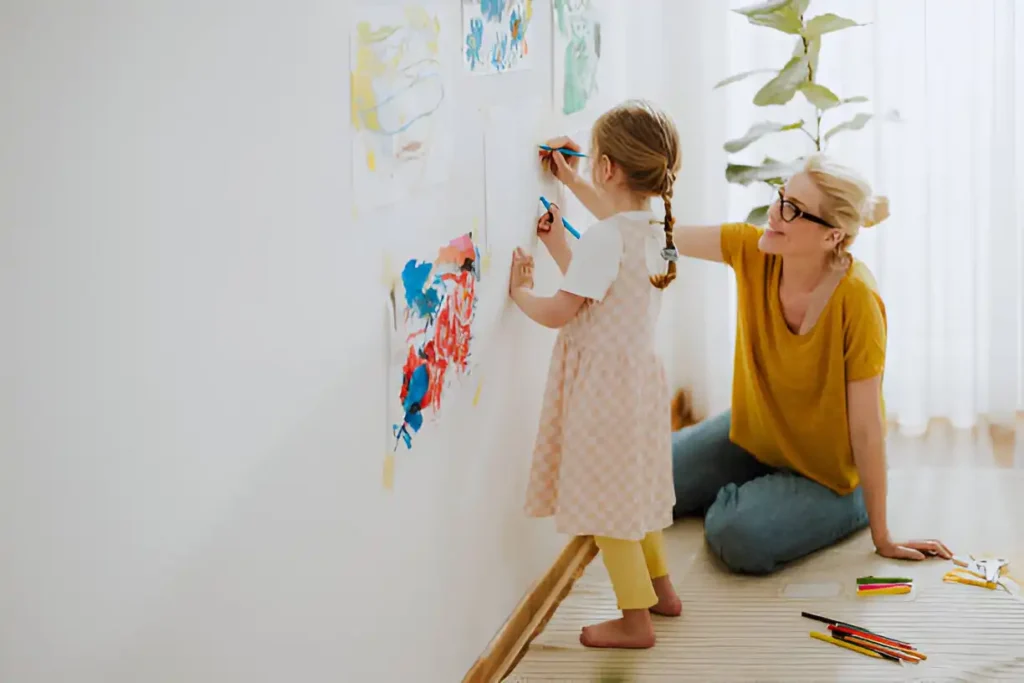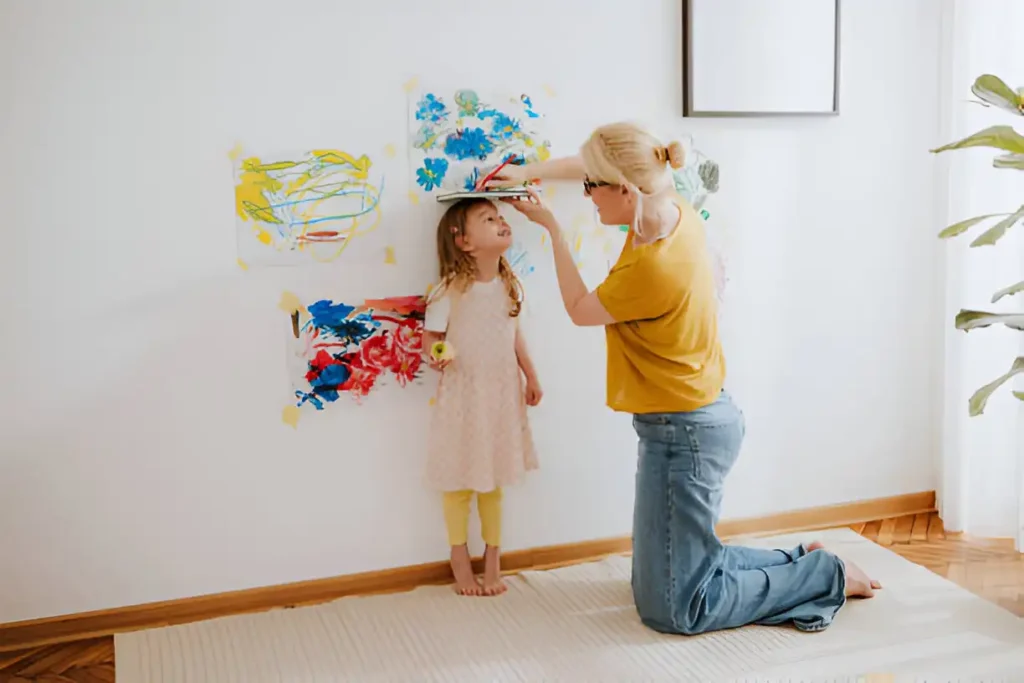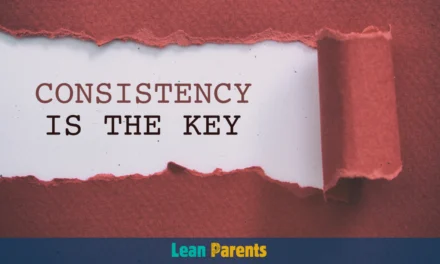Parenting is a journey filled with joy and challenges. It’s a constant learning experience. You might wonder how to balance showing love and setting limits.
This balance is a daily struggle. Remember that time your child threw a tantrum in the grocery store? You felt torn between comforting them and enforcing rules. That’s the delicate balance we’re talking about.
Balancing positivity and boundaries in parenting is crucial. It’s not just a nice-to-have skill; it’s essential. This guide will show you five proven strategies to help you nurture your child’s growth while maintaining necessary limits.
Whether you’re a new parent or a seasoned pro, these parenting tips will help. They will help you create a loving, structured environment where your child can thrive.
Key Takeaways
- Positive parenting fosters emotional intelligence in children
- Consistent boundaries provide a sense of security for kids
- Effective communication is crucial for setting and enforcing limits
- Balancing praise with constructive feedback promotes growth
- Adapting parenting strategies as children grow is important
- Self-care for parents is essential in maintaining balance
Understanding the Importance of Balancing Positivity and Boundaries
Parenting is a delicate dance between nurturing and guiding your child. Finding the right balance between positivity and boundaries is key. This balance shapes your child’s development in deep ways. Let’s dive into why it’s so important for effective parenting.
The role of positivity in child development
Positivity is vital in shaping your child’s view of life. It builds their self-esteem and confidence. Children raised in supportive homes develop better social skills and emotional strength.
Why boundaries are crucial for healthy parenting
Setting clear boundaries is just as important as being positive. Boundaries give structure and help children understand what’s expected. They teach self-control and respect for others, creating a sense of security.
The challenge of finding the right balance
Finding the right balance between positivity and boundaries is tricky. Too much positivity can lead to entitlement. On the other hand, too many boundaries can stifle growth. The goal is to mix warmth with firm guidance.
| Aspect | Too Much Positivity | Balanced Approach | Too Many Boundaries |
|---|---|---|---|
| Child’s Behavior | Entitled, lack of self-control | Respectful, self-disciplined | Fearful, overly compliant |
| Emotional Development | Poor emotional regulation | Healthy emotional intelligence | Suppressed emotions |
| Social Skills | Difficulty with peer relationships | Strong social connections | Struggle to form close bonds |
Understanding the importance of both positivity and boundaries helps you create a nurturing environment. This environment allows your child to thrive. The next sections will offer practical tips for achieving this balance in your parenting journey.
The Impact of Positive Parenting on Child Behavior

Positive parenting has a big impact on how kids behave. Children raised this way tend to have better control over their emotions and social skills. They learn to handle their feelings and get along with others.
Studies show that kids of positive parents are more confident and resilient. They deal with stress better and recover from setbacks faster. This parenting style helps kids feel good about themselves.
Positive parenting also means fewer behavior problems. Kids are more likely to follow rules and make good choices when parents set clear boundaries. They know what’s expected of them and what happens if they don’t meet those expectations.
The good effects of positive parenting last a long time. These kids often grow up to be well-adjusted adults with strong relationships. They’re ready to face life’s challenges and do well in many areas.
| Aspect | Impact of Positive Parenting |
|---|---|
| Emotional Regulation | Better control of emotions |
| Social Skills | Improved interactions with others |
| Self-Esteem | Higher confidence levels |
| Behavior | Fewer disciplinary issues |
| Long-term Outcomes | Well-adjusted adulthood |
By using positive reinforcement and clear communication, you can greatly improve your child’s behavior. Remember, being consistent is crucial in positive parenting.
Setting Clear and Consistent Boundaries: A Foundation for Success

Setting clear boundaries is key to good parenting. It makes a safe space for your child to learn and grow. Here are some tips for setting and keeping boundaries.
Defining Age-Appropriate Boundaries
Your child’s age affects what boundaries are right for them. Toddlers need safety rules like “no hot stoves.” As they get older, rules change to include screen limits, curfews, and chores.
Communicating Boundaries Effectively
Clear talk is important for setting boundaries. Use simple words and explain why rules are in place. For example, “We brush teeth at night to keep them healthy.” This helps kids understand and accept rules better.
Consistency: The Key to Boundary Enforcement
Being consistent is key to keeping boundaries. Always follow your rules, even when it’s hard. If bedtime is 8 PM, stick to it. This makes kids feel safe and know what to expect.
“Boundaries are not meant to restrict, but to provide a safe space for growth and exploration.”
Remember, setting boundaries is showing love. It shows your child you care about their safety and want to help them succeed. By following these tips, you’re building a strong base for their future.
Fostering Emotional Intelligence in Children
Building emotional intelligence in kids is crucial for raising well-rounded adults. This skill helps them understand and manage their feelings. It leads to better relationships and success in life. Let’s look at some parenting tips to boost your child’s emotional smarts.
Begin by teaching your child to name their emotions. Use simple words like happy, sad, angry, or scared. When they can label their feelings, they’re better at handling them. Use books, games, or everyday situations to practice this skill.
Next, show empathy when your child is upset. Listen without judgment and validate their feelings. This builds respect and equality with your child, creating a safe space for them to express themselves.
Help your child problem-solve when faced with emotional challenges. Guide them through steps to resolve conflicts or cope with disappointment. This builds resilience and teaches valuable life skills.
“Emotional intelligence is the ability to sense, understand, and effectively apply the power and acumen of emotions as a source of human energy, information, connection, and influence.” – Robert K. Cooper
Model emotional intelligence yourself. Kids learn by watching their parents. Show them how you handle your own emotions in a healthy way. This real-life example is one of the most powerful parenting tips you can use.
| Emotion | Recognition Cue | Healthy Response |
|---|---|---|
| Anger | Clenched fists, raised voice | Deep breaths, count to ten |
| Sadness | Tears, withdrawn behavior | Express feelings, seek comfort |
| Joy | Smiling, laughter | Share happiness with others |
| Fear | Trembling, avoidance | Identify the cause, seek support |
By focusing on these strategies, you’ll help your child develop strong emotional intelligence. This skill set will serve them well throughout their life, improving their relationships and overall well-being.
The Power of Positive Reinforcement in Parenting
Positive reinforcement is a game-changer in parenting. It shapes behavior and builds strong bonds between parents and children. Let’s explore how to use it to help your child grow and thrive.
Types of Positive Reinforcement
There are many ways to use positive reinforcement. Verbal praise, hugs, and rewards are just a few. Each child is different, so find what works best for yours. Effective communication is crucial for delivering reinforcement that your child will appreciate.
| Reinforcement Type | Examples | Best Used For |
|---|---|---|
| Verbal Praise | “Great job!”, “I’m proud of you” | Boosting confidence, encouraging effort |
| Physical Affection | Hugs, high-fives, pats on the back | Emotional bonding, comfort |
| Tangible Rewards | Stickers, extra screen time, special treats | Motivating specific behaviors, goal achievement |
Using Praise Effectively
Timing is everything with praise. Give feedback right away when you see good behavior. Be specific, focusing on effort and process, not just results. This helps your child develop a growth mindset and resilience.
Balancing Praise with Feedback
While praise is key, balance is essential. Constructive feedback helps children learn and grow. When giving feedback, focus on the behavior, not the child. Use “I” statements and suggest ways to improve. This balanced approach is a valuable parenting tip.
“The way we talk to our children becomes their inner voice.”
Remember, positive reinforcement isn’t about being perfect. It’s about creating a supportive environment where your child feels valued and motivated to be their best self.
Implementing Consequences Without Compromising Positivity
It’s hard to balance being positive and setting boundaries in parenting, especially with consequences. The trick is to stay positive while dealing with bad behavior. Here are some tips to help you:
- Use natural consequences: Let your child see the effects of their actions when it’s safe. This teaches them responsibility without hurting your positive bond.
- Communicate clearly: Tell your child why they’re facing a consequence calmly. This helps them see how their actions led to the outcome.
- Be consistent: Always follow through on consequences. Being consistent helps your child feel secure and teaches them boundaries.
- Focus on learning: See consequences as chances to grow, not just punishment. This keeps things positive while addressing the issue.
- Offer choices: When you can, let your child choose how to make things right. This gives them power and keeps things positive.
The aim is to guide your child’s behavior while keeping a supportive atmosphere. By using these strategies, you can set boundaries without losing the positive side of parenting.
“Discipline is helping a child solve a problem. Punishment is making a child suffer for having a problem. To raise problem solvers, focus on solutions, not retribution.”
It takes practice to balance positivity and boundaries, but it’s worth it. These tips can help you create a loving space where your child feels guided and loved.
Building Strong Parent-Child Relationships Through Open Communication
Open communication is key to strong parent-child bonds. It builds trust and understanding. This leads to meaningful talks that help your child grow emotionally.
Active Listening Techniques for Parents
Active listening is crucial in talking to your child. Always listen fully when they speak. Make eye contact, nod, and say things like “I see” or “Tell me more.” It shows you care about their thoughts and feelings.
Encouraging Children to Express Their Feelings
Help your child share their feelings. Ask questions like “How did that make you feel?” Even if you don’t agree with their actions, validate their emotions. This boosts their emotional smarts and strengthens your connection.
Creating a Safe Space for Dialogue
Make a place where your child feels safe to talk. Set up regular “chat times” without distractions. This special time helps your child feel heard and valued.
“The greatest gift you can give your child is the power of being heard.”
Effective communication is a two-way street. By using these methods, you build trust and understanding. This will benefit your family for many years.
Balancing Discipline and Nurture: Finding the Sweet Spot
Parenting is a delicate dance between discipline and nurture. Finding the right balance is tricky but crucial for raising happy kids. Let’s explore some tips to help you find that perfect balance.
Discipline doesn’t mean punishment. It’s about teaching right from wrong and helping kids develop self-control. Nurture involves showing love, support, and encouragement. Both are key for your child’s growth.
Here’s a simple guide to help you balance discipline and nurture:
| Discipline | Nurture |
|---|---|
| Set clear rules | Show affection regularly |
| Use consistent consequences | Offer praise for good behavior |
| Teach problem-solving skills | Listen to your child’s feelings |
| Encourage responsibility | Provide emotional support |
Remember, every child is unique. What works for one might not work for another. Be flexible and adjust your parenting style as needed. The key is to maintain a loving environment while enforcing necessary boundaries.
“The goal is not to control but to teach, not to punish but to correct.”
By finding the sweet spot between discipline and nurture, you’ll create a positive home atmosphere. This atmosphere fosters growth, respect, and love. It’s a challenging task, but with patience and practice, you’ll master this essential parenting skill.
The Role of Self-Care in Maintaining Parental Balance
Parenting is a tough job that needs lots of energy and patience. To stay positive and set good boundaries, self-care is key. Taking care of yourself is not selfish; it’s crucial for being a great parent.
Self-care for parents can be many things. Regular exercise, a healthy diet, and enough sleep are important for your body. Also, finding time for hobbies, meditation, or a quiet coffee can help your mind.
One great tip for parents is to make time for yourself. This might mean getting a babysitter for a few hours or swapping childcare with friends. Use this time to do things that make you happy and relaxed.
“You can’t pour from an empty cup. Take care of yourself first.”
Self-care isn’t just about treating yourself. It’s also about saying “no” to work, social events, and even your kids. Saying “no” to things you don’t need to do gives you more time and energy for what’s important.
By focusing on self-care, you’re teaching your kids about balance and self-respect. This helps create a positive family atmosphere where everyone’s needs are considered and met.
Adapting Parenting Strategies as Children Grow
Parenting tips change as your kids grow. It’s key to balance caring for them and setting rules. Let’s look at how to adjust your parenting as your child grows.
Adjusting Boundaries for Different Age Groups
As kids get older, they want more freedom. You need to change how you parent to fit their age. Toddlers need safety rules. School-age kids need rules about screens and friends. Teens want to make some of their own choices.
| Age Group | Boundary Focus | Parenting Approach |
|---|---|---|
| Toddlers (2-3) | Safety, basic routines | Consistent, simple rules |
| Preschoolers (4-5) | Behavior, sharing | Positive reinforcement |
| School-age (6-12) | Responsibilities, screen time | Logical consequences |
| Teens (13-18) | Privacy, social life | Negotiation, trust-building |
Evolving Communication Styles
Your way of talking to your child should change as they grow. Young kids need simple words and examples. Older kids can handle more complex talks. Always listen and show you care to keep the conversation open.
Maintaining Positivity Through Developmental Stages
Staying positive is key during tough times. Celebrate your child’s big moments and their hard work. Use praise wisely to help them grow. Your positive vibe helps your family stay connected and balanced.
By changing your parenting, you help your child grow in a supportive way. Be flexible and patient as you both learn and grow together.
Overcoming Common Challenges in Balancing Positivity and Boundaries
Balancing positivity and boundaries in parenting can be tricky. You might face struggles like inconsistency, guilt, or feeling overwhelmed. Let’s explore some practical parenting tips to help you navigate these challenges.
One common hurdle is maintaining consistency. Kids thrive on routine, so stick to your rules even when tired. Create a visual chart of family rules and consequences to keep everyone on track.
Guilt often creeps in when setting boundaries. Remember, boundaries show love and care. They teach kids valuable life skills and help them feel secure. Embrace the long-term benefits of your parenting choices.
Feeling overwhelmed? Break down your parenting goals into smaller, manageable steps. Focus on one area at a time, like bedtime routines or mealtime behavior. Celebrate small wins along the way.
| Challenge | Solution |
|---|---|
| Inconsistency | Create a visual rule chart |
| Parental guilt | Focus on long-term benefits |
| Feeling overwhelmed | Break goals into smaller steps |
By addressing these common challenges, you’ll find it easier to strike a balance between positivity and boundaries in your parenting journey. Remember, perfection isn’t the goal – progress is what matters most.
Incorporating Mindfulness into Positive Parenting Practices
Mindfulness can change how you parent, making you more present and thoughtful with your kids. It helps create a caring space where everyone grows emotionally and connects better.
Begin your day with a short meditation. Just a few deep breaths and a mindful intention can set you up for calm, centered parenting.
Listen mindfully during daily tasks. Focus fully on your child, making eye contact and really hearing them. This builds a stronger bond and shows your child they matter.
Add mindful breathing to your family’s routine. Teach your kids to breathe deeply when they’re upset. It helps them manage feelings and learn to control their emotions.
“Mindfulness in parenting allows us to pause before reacting, creating space for thoughtful responses.”
Be mindful during playtime. See the happiness and curiosity in your child’s actions without judging. This practice makes you appreciate the moment more and strengthens your bond.
Remember, mindfulness in parenting is a journey. Be kind to yourself as you learn. Your efforts will lead to a more peaceful and emotionally smart family.
The Long-Term Benefits of Balanced Parenting Approaches
Balanced parenting tips lay a strong foundation for your child’s future. By mixing positivity with clear rules, you prepare them for success. These benefits last long after they grow up.
Impact on Child’s Self-Esteem and Confidence
Right balance in parenting boosts your child’s self-worth. Praise their hard work and successes, but also give feedback. This builds a true self-image and confidence to face new challenges.
Fostering Independence and Responsibility
Balanced parenting helps kids think for themselves. By setting the right expectations and letting them take risks, you teach them to make decisions. This builds their sense of responsibility and prepares them for adulthood.
Building Resilience for Future Challenges
Life has ups and downs, and balanced parenting prepares your child for them. By letting them handle small challenges, you teach them to solve problems. This resilience is crucial as they face life’s challenges.
| Parenting Approach | Long-Term Benefit |
|---|---|
| Positive Reinforcement | Increased Self-Esteem |
| Clear Boundaries | Enhanced Self-Discipline |
| Encouraging Independence | Improved Problem-Solving Skills |
| Open Communication | Strong Emotional Intelligence |
Consistency is crucial in balanced parenting. Your steady effort today will shape your child’s bright future.
Real-Life Examples of Successful Boundary Setting with Positivity
Positive parenting and clear boundaries make a great mix for kids. Let’s look at some real-life examples of parents who got it right.
One family started a “screen time token” system. Kids got tokens for doing chores and being good. They could trade these for screen time. This taught them responsibility in a positive way.
Another parent created a “quiet corner” instead of time-outs. When kids needed to calm down, they went to a cozy spot with books and soft toys. This method set boundaries without punishment, helping kids learn to self-regulate.
A creative mom set up a “compliment jar.” Family members wrote notes about each other’s positive actions. At the end of the week, they read the notes together. This way, they praised good behavior and encouraged it.
| Boundary Strategy | Positive Approach | Outcome |
|---|---|---|
| Screen time tokens | Rewards for good behavior | Improved responsibility |
| Quiet corner | Calm-down space | Better self-regulation |
| Compliment jar | Praise for good actions | Reinforced positive behavior |
These examples show how boundaries and positive parenting can go hand in hand. By setting clear rules with love, parents create a balanced place for their kids to grow and thrive.
Conclusion
Learning to balance positivity and boundaries is crucial for a better family life. By following these tips, you can make a safe space for your kids to grow. It’s important to remember that setting limits doesn’t mean you can’t be supportive and positive.
Using these strategies will improve your bond with your kids. They’ll feel safer, learn to control themselves better, and become more confident. Your consistent effort in balancing positivity and boundaries will prepare them for life’s ups and downs.
Begin with small steps and be kind to yourself as you start. Every family is different, so adjust these tips to suit your needs. With time and effort, you’ll find the right balance for your family. This will create a loving and peaceful home for everyone.






Центр репродуктологии в СПб: новейшие технологии и индивидуальный подход к лечению бесплодия
клиника эко спб [url=http://reproductologyonline.ru/]http://reproductologyonline.ru/[/url] .
Как сдавать спермограмму в СПб: полное руководство по подготовке и проведению анализа
где сдать спермограмму в спб [url=eggdonorsspb.ru]eggdonorsspb.ru[/url] .
ЭКО по ОМС в СПб: минимизация затрат на лечение бесплодия
эко квота [url=https://embryoscopespb.ru/]эко квота[/url] .
Каркасные дома под ключ: почему это идеальный выбор для семейного загородного дома
одноэтажный каркасный дом [url=https://www.karkasnye-doma-pod-klyuch-msk1.ru/odnoetazhnye]https://www.karkasnye-doma-pod-klyuch-msk1.ru/odnoetazhnye[/url] .
Online Stamp Maker for Personalized Gift Ideas
stamps maker [url=https://stamp-online-maker.com]https://stamp-online-maker.com[/url] .
Как выбрать банк для ипотеки в Бишкеке: рейтинг и отзывы 2024 года
ипотека kg [url=http://www.ipotekakg.ru/]http://www.ipotekakg.ru/[/url] .
Микрозаймы без отказа на карту: срочная финансовая помощь для любых нужд
займ на карту [url=https://www.dengikg.ru]https://www.dengikg.ru[/url] .
Мобильные экраны для проекторов: удобное решение для презентаций
экран для проектора цена [url=https://ehkrany-dlya-proektorov0.ru]https://ehkrany-dlya-proektorov0.ru[/url] .
Каркасный дом под ключ: строительство мечты за разумные деньги
каркасные дома под ключ в спб цены [url=http://www.karkasnyi-dom-pod-klyuch-1.ru/]http://www.karkasnyi-dom-pod-klyuch-1.ru/[/url] .
Доступные серверы HP Proliant, Выгодные предложения на серверы HP Proliant
сервер делл купить [url=https://servera-hp-proliant.ru/]https://servera-hp-proliant.ru/[/url] .
Казино Клубника: наслаждайтесь азартом с максимальным комфортом
казино клубника зеркало [url=http://dscol-oktr.ru/clubnika/]http://dscol-oktr.ru/clubnika/[/url] .
Монтаж септиков: от планирования до ввода в эксплуатацию
септик купить москва [url=https://www.septik-pod-kluch-moskwa.ru/]https://www.septik-pod-kluch-moskwa.ru/[/url] .
Design and Order Personalized Stamps Online for Any Occasion
stamp maker online free [url=https://stampingandblogging.com/]stamp maker online free[/url] .
Вывод из запоя на дому в Самаре: медицинский контроль и безопасное восстановление
вывод из запоя недорого в самаре [url=http://www.vivod-iz-zapoya-63.ru/]http://www.vivod-iz-zapoya-63.ru/[/url] .
Custom Rubber Stamps Online: Fast and Convenient Solutions
free stamp maker online [url=https://stampwebshop.com/]free stamp maker online[/url] .
Где и как быстро оформить пропуск на МКАД для грузовых машин
пропуск в москву для грузовиков [url=https://propusknamkad13.ru]https://propusknamkad13.ru[/url] .
Каркасные дома по доступным ценам: современные технологии строительства
строительство каркасных домов в санкт-петербурге [url=https://karkasnye-doma-v-spb178.ru/]строительство каркасных домов в санкт-петербурге[/url] .
Проекты каркасных домов: от стандартных решений до индивидуального дизайна
дом каркасный под ключ [url=https://karkasnye-doma-v-spb-pod-kluch1.ru]https://karkasnye-doma-v-spb-pod-kluch1.ru[/url] .
Септики под ключ: экономичное решение для загородного дома
септик цена под ключ [url=https://www.septik-pod-klych-99.ru]https://www.septik-pod-klych-99.ru[/url] .
Строителство на сглобяеми къщи: практични и изгодни решения за всеки
сглобяеми къщи цени до ключ [url=http://sglobyaemi-kushti.com/]http://sglobyaemi-kushti.com/[/url] .
Получите грузовой автомобиль в лизинг с минимальным пакетом документов
грузовой автомобиль в лизинг [url=https://www.lizing-gruzovyh-avto.ru]https://www.lizing-gruzovyh-avto.ru[/url] .
Первый прыжок с парашютом: доверяйте только профессионалам
прыжки с парашютом 3000 метров [url=http://www.pryzhki-s-parashyutom-v-spb.ru/]http://www.pryzhki-s-parashyutom-v-spb.ru/[/url] .
Discover the top online schools in Wisconsin, with detailed rankings and reviews.
Enroll in a reputable online school in Wisconsin, to kickstart your learning experience.
Study online from anywhere in Wisconsin, with adaptable timetables and one-on-one guidance.
Improve your professional options with an online certificate in Wisconsin, from recognized online institutions in Wisconsin.
Realize your educational aspirations with an online program in Wisconsin, tailored to fit your needs and schedule.
Interact with peers in digital learning environments in Wisconsin, and create valuable connections for your career.
Benefit from online libraries and databases for your studies in Wisconsin, to excel in your online education and succeed in your online school.
Online Schools in Wisconsin [url=https://onlineschoolwi6.com/]Online Schools in Wisconsin[/url] .
Купить объемные наклейки: выгодные условия и высокое качество
объемные стикеры на заказ москва [url=http://xn—–7kcbbyacb2akkclkqcl8a3dxf3b0a4b.xn--p1ai/]http://xn—–7kcbbyacb2akkclkqcl8a3dxf3b0a4b.xn--p1ai/[/url] .
Эффективное лечение в наркологической клинике СПб: шаг к свободе
наркология в спб [url=http://www.narkologicheskaya-klinika-spb-1.ru/]http://www.narkologicheskaya-klinika-spb-1.ru/[/url] .
Наркологическая клиника: начните лечение сегодня и верните свою жизнь
наркологическая клиника санкт петербург [url=https://www.narkologicheskaya-klinika-spb-0.ru]https://www.narkologicheskaya-klinika-spb-0.ru[/url] .
Каркасный дом под ключ: цена, проекты и сроки строительства
каркасный дом под ключ в спб цена [url=https://www.karkasnye-doma-v-spb-1.ru/]https://www.karkasnye-doma-v-spb-1.ru/[/url] .
Каркасный дом в современном дизайне: красивые проекты для всей семьи
каркасный дом [url=https://karkasnye-doma-v-spb-pod-kluch.ru/]https://karkasnye-doma-v-spb-pod-kluch.ru/[/url] .
Строительство деревянных домов под ключ: от фундамента до отделки
дом деревянный под ключ [url=https://derevyannye-doma-pod-klyuch777.ru/]https://derevyannye-doma-pod-klyuch777.ru/[/url] .
Сглобяеми къщи с гарантирано качество: комфортен дом за кратко време
готови проекти за сглобяеми къщи с метална конструкция [url=https://sglobyaemi-kushti.com/]готови проекти за сглобяеми къщи с метална конструкция[/url] .
Казино Клубника: начните свой игровой путь с лучшими условиями
казино клубника зеркало [url=https://goo.su/rcfb/]https://goo.su/rcfb/[/url] .
Камера заднего вида для грузовых машин: улучшите видимость и сократите риски
камера заднего вида грузовая [url=https://kamera-dlya-gruzovika.ru/]https://kamera-dlya-gruzovika.ru/[/url] .
Наклейки со смолой на заказ: для бизнеса, рекламы и сувениров
объемные наклейки на заказ москва [url=http://xn—–7kcbbyacb2akkclkqcl8a3dxf3b0a4b.xn--p1ai/]http://xn—–7kcbbyacb2akkclkqcl8a3dxf3b0a4b.xn--p1ai/[/url] .
Интернет-магазин шин: гарантия качества и быстрая доставка
интернет магазин резины [url=http://shiny-internet-magazin.ru/]http://shiny-internet-magazin.ru/[/url] .
Кредит на карту от банка: получите деньги за 5 минут
кредит с плохой историей [url=https://www.kreditkg.ru]https://www.kreditkg.ru[/url] .